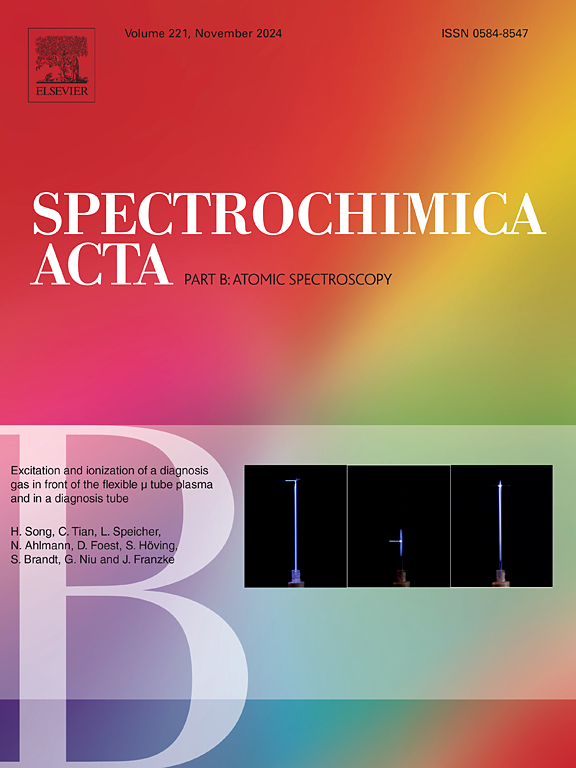Up-conversion of 780 nm or 795 nm laser radiation to 420 nm in rubidium atomic vapor
IF 3.8
2区 化学
Q1 SPECTROSCOPY
引用次数: 0
Abstract
We demonstrate efficient laser-induced fluorescence (LIF) at 420 nm — corresponding to the Rb transition — induced by 780 nm or 795 nm laser radiation, which is nearly resonant via a two-photon excitation pathway involving the transition. We use a 1-cm-long T-shaped all-sapphire cells containing Rb vapor and different pressures of Ne buffer gas. The dependence of 420 nm LIF intensity on temperature, buffer gas pressure, and excitation wavelength is analyzed. The optimal conditions for achieving bright blue-violet emission are established. Practical applications of this up-conversion process are discussed. The results demonstrate the potential for using Rb vapor cells as compact and efficient optical up-conversion filters, converting near-infrared laser radiation into visible blue emission.

在铷原子蒸气中将780 nm或795 nm激光辐射上转换为420 nm
在780 nm或795 nm的激光辐射下,我们在420 nm处发现了有效的激光诱导荧光(LIF),对应于Rb 6P3/2→5S1/2跃迁,该荧光通过涉及5S1/2→5D3/2跃迁的双光子激发途径几乎共振。我们使用1厘米长的t型全蓝宝石电池,其中含有Rb蒸气和不同压力的Ne缓冲气体。分析了420 nm LIF强度与温度、缓冲气体压力和激发波长的关系。确定了实现明亮蓝紫色发光的最佳条件。讨论了该上转换工艺的实际应用。结果表明,使用Rb蒸汽电池作为紧凑高效的光学上转换滤波器,将近红外激光辐射转换为可见的蓝色发射具有潜力。
本文章由计算机程序翻译,如有差异,请以英文原文为准。
求助全文
约1分钟内获得全文
求助全文
来源期刊
CiteScore
6.10
自引率
12.10%
发文量
173
审稿时长
81 days
期刊介绍:
Spectrochimica Acta Part B: Atomic Spectroscopy, is intended for the rapid publication of both original work and reviews in the following fields:
Atomic Emission (AES), Atomic Absorption (AAS) and Atomic Fluorescence (AFS) spectroscopy;
Mass Spectrometry (MS) for inorganic analysis covering Spark Source (SS-MS), Inductively Coupled Plasma (ICP-MS), Glow Discharge (GD-MS), and Secondary Ion Mass Spectrometry (SIMS).
Laser induced atomic spectroscopy for inorganic analysis, including non-linear optical laser spectroscopy, covering Laser Enhanced Ionization (LEI), Laser Induced Fluorescence (LIF), Resonance Ionization Spectroscopy (RIS) and Resonance Ionization Mass Spectrometry (RIMS); Laser Induced Breakdown Spectroscopy (LIBS); Cavity Ringdown Spectroscopy (CRDS), Laser Ablation Inductively Coupled Plasma Atomic Emission Spectroscopy (LA-ICP-AES) and Laser Ablation Inductively Coupled Plasma Mass Spectrometry (LA-ICP-MS).
X-ray spectrometry, X-ray Optics and Microanalysis, including X-ray fluorescence spectrometry (XRF) and related techniques, in particular Total-reflection X-ray Fluorescence Spectrometry (TXRF), and Synchrotron Radiation-excited Total reflection XRF (SR-TXRF).
Manuscripts dealing with (i) fundamentals, (ii) methodology development, (iii)instrumentation, and (iv) applications, can be submitted for publication.

 求助内容:
求助内容: 应助结果提醒方式:
应助结果提醒方式:


